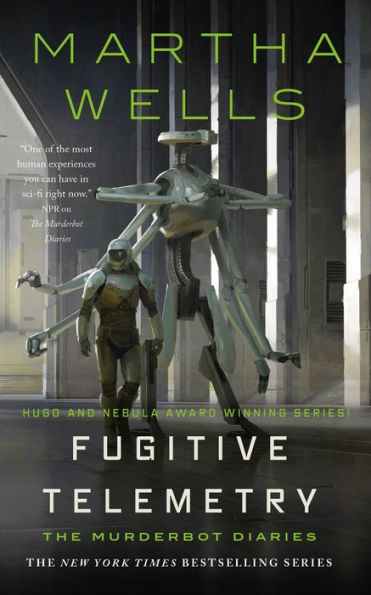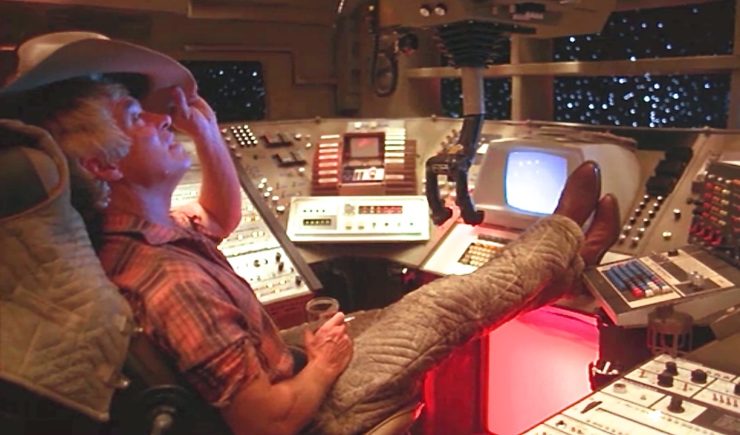Star Wars was widely hailed as a space western. So Roger Corman, with his talent for the obvious, decided to remake it by adding 90% more Westernness. George Lucas, in making his film, borrowed some scenes and visuals from John Ford’s The Searchers. Corman, in 1980’s Battle Beyond the Stars, ripped off the plot of The Magnificent Seven wholesale—a theft which was all the more brazen since The Magnificent Seven was already a shameless imitation of Kurosawa’s Seven Samurai.
Once again, peasants threatened by ruthless marauders seek help from a ragged band of underdog mercenaries… but this time in space, with the swords-replaced-by guns replaced, one final time, by futuristic energy weapons.
Kurosawa’s story is a sturdy narrative, and it works a lot better here, in third-hand repetition, than it has any right to. A young James Cameron provides inventive special effects for Battle Beyond the Stars, including a range of lumpily idiosyncratic spacecraft. Veteran character actors like Robert Vaughn, George Peppard, and an improbably exposed Sybil Danning all overact with spectacular enthusiasm as they join young Shad (Richard Thomas) to defend the peaceful farmers of Akira from the bloodthirsty Malmori. John Saxon as the evil Sador (as opposed to Vader) rants, bugs his eyes out, and pulls off hunks of space scenery to stuff into his shouty maw. There are explosions, daring ship-to-ship combat, a Star Trek riff in which the sheltered space-woman Nanella (Darlanne Fluegel) learns about sex, and scads of noble deaths.
There’s also a surprisingly seamless fit between western tropes and science fiction ones. Part of that is that both genres enjoy a good gunfight, replete with swash and buckle. But a lot of it is also the way both science fiction and the Western are built on analogous—and, it turns out, compatible—fantasies of colonial violence and colonial disavowal.
Despite the Western nods and references, the bad guys in Star Wars command soldiers called stormtroopers, and iconographically reference the Nazis. The Empire’s atrocities aren’t specifically about the Holocaust since they aren’t directed at particular racialized groups, but to the extent they have any real-world analogue, they nod to twentieth-century genocides.
In contrast, the evil Malmori fly malevolently out of earlier science fiction tropes. The invasion of Akira follows the blueprint of Wells’ War of the Worlds, in which marauders from the skies swoop down with superior technology to murder, enslave, and rob (Sador makes a point of laying claim to the Akirans’ harvest). In The War of the Worlds, the Martians’ cruel rampage is directly compared to British depredations and genocide in Tasmania; the terror for English readers was that the Martians are doing to us what we did to indigenous Tasmanians.
Wells was thinking of the fate of British colonies when he wrote his novel, but the metaphorical inversion works quite well for westward expansion in the Americas too. In Battle Beyond the Stars, the peaceful white Akirans take the place of native peoples, while the mutant, eugenically imperfect Malmori substitute for the white American invaders awash with megalomaniacal greed and superior firepower. As a further twist, the heroes are a motley crew of racially diverse aliens: green reptilians, blue-white collectivist clones, buxom space Valkyries. Rather than a white savior protecting indigenous people, you have sort of not-white saviors riding (or jetting) to the rescue—foreshadowing the 2016 Magnificent Seven remake.
That remake actually featured actors of color, however, most notably Denzel Washington in the lead. The aliens in BBTS, in contrast, are all played by white performers. As critics have noted in the past, science fiction often seems to have an easier time imagining green or red people in space than it does putting Black or brown ones on a distant planet.
Buy the Book


Fugitive Telemetry
The movie certainly doesn’t include any Native American actors. Instead, Akiran society is presented as a vaguely New Age echo of Asian and/or Native beliefs. Shad espouses peace one minute, and then quotes bastardized Sun Tzu aphorisms about battle strategy the next. “All our wealth is in our culture,” he asserts, inadvertently explaining BBTS’s own profit-making strategy. Whites have robbed indigenous people of their land and wealth, but the theft isn’t done. Native stories and experiences continue to have value, when suitably repackaged, decontextualized, and whitewashed by those like Corman.
In Nothing Ever Dies: Vietnam and the Memories of War, Viet Thanh Nguyen suggests that the American war machine and the Hollywood machine of memories are part of a single powerful, futuristic whole. “If we look at a spectacular war movie such as American Sniper in isolation,” he says, “it appears to be a part of a memory industry, but if we look at that movie as a part of Hollywood, and Hollywood as a component of the military-industrial complex, then we see an industry of memory in operation. The ultimate goal of that industry is to reproduce power and inequality, as well as to fulfill the needs of the war machine.”
Battle Beyond the Stars deliberately and self-consciously acknowledges the continuity of storytelling and warfare through George Peppard’s flamboyant Cowboy, with his ten-gallon hat, his harmonica, and his library of classic film Westerns in his ship. Cowboy embodies the old movie genre, and brings it forward into the present and future by teaching the Akirans the battle skills he’s learned from watching all those onscreen shoot-outs. Old Hollywood teaches us how to fight today—and part of what we’re fighting for is the power to remember the past through the mythic filter of old Hollywood.
Cowboy lets you know the filmmakers are in on the joke; they remember. But he also lets you know that the joke is maintained through forgetting. The symbol of the real and imagined past is not an indigenous person, whose story we’re retelling, but the white man who took the land. And then, as a final twist of the Bowie knife, he took the story too. The disproportionate power which allowed the removal of native people also allows a removal and rewriting of memory. Sador’s terrible stellar converter, turning light to genocide, is no more powerful than Hollywood cameras, which do exactly the same thing.
Westerns and science fiction invasion stories both frequently, even compulsively, reenact traumatic ethnic cleansing on an imagined landscape from which the victims have already quietly been cleansed. Wells’ Martians reprise the murder of the Tasmanians in a novel entirely populated by white people, with the Tasmanians carefully bracketed on the margins of the story. Similarly, the Malmori pantomime the genocide of Native Americans on a stage from which Native Americans have been removed, their parts taken over by white actors. Battle Beyond the Stars shows that the old West and science fiction’s new planets are both landscapes cleared for exciting action. And that exciting action is precisely the reenactment of clearing the landscape: The weird aliens die. The white settlers hold onto the land. It’s the business of the western, and the space western, to shuffle around the genre markers in such a way that this outcome looks like a happy ending.
Noah Berlatsky is the author of Wonder Woman: Bondage and Feminism in the Marston/Peter Comics (Rutgers University Press).










